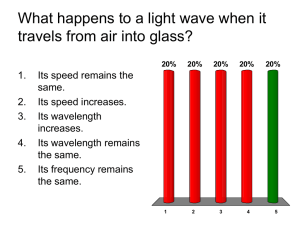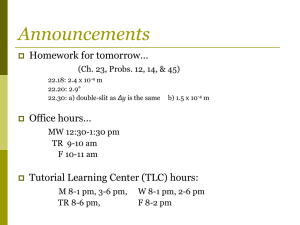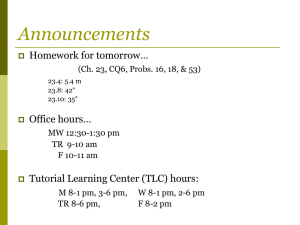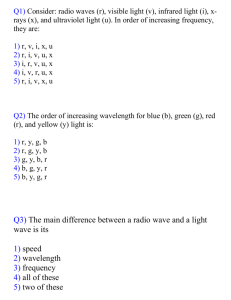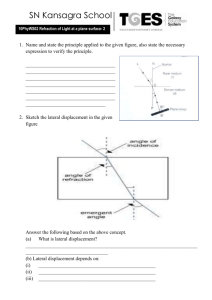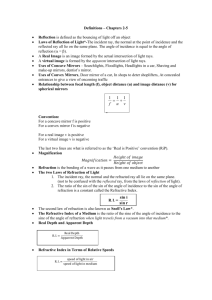1 - Uplift Education
advertisement
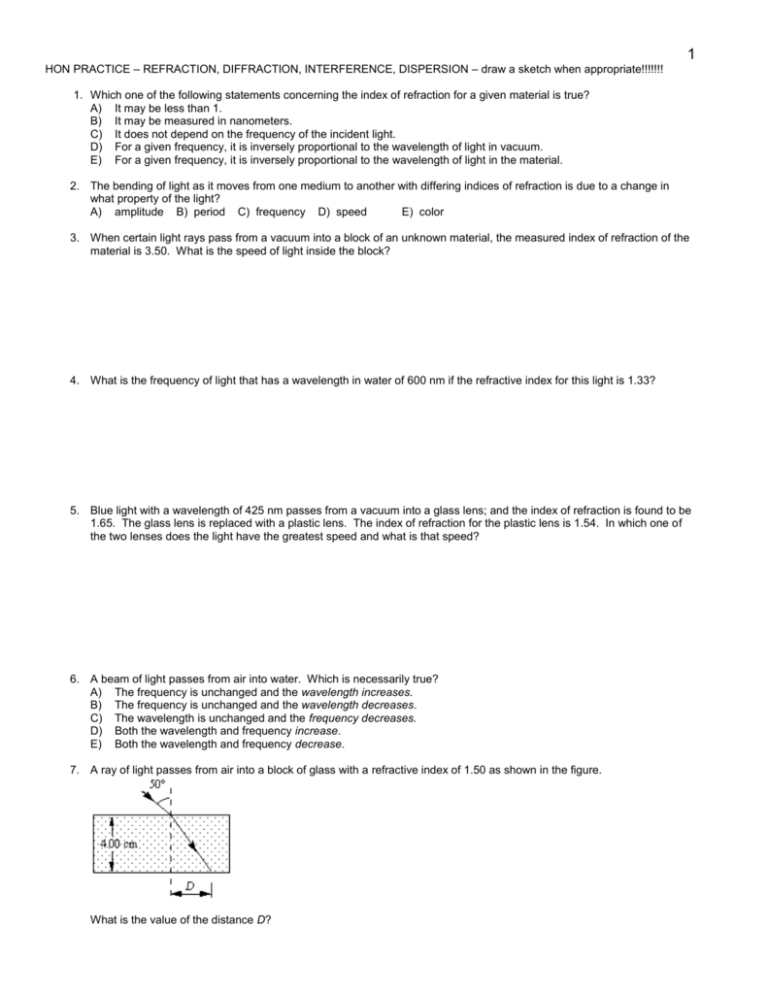
1 HON PRACTICE – REFRACTION, DIFFRACTION, INTERFERENCE, DISPERSION – draw a sketch when appropriate!!!!!!! 1. Which one of the following statements concerning the index of refraction for a given material is true? A) It may be less than 1. B) It may be measured in nanometers. C) It does not depend on the frequency of the incident light. D) For a given frequency, it is inversely proportional to the wavelength of light in vacuum. E) For a given frequency, it is inversely proportional to the wavelength of light in the material. 2. The bending of light as it moves from one medium to another with differing indices of refraction is due to a change in what property of the light? A) amplitude B) period C) frequency D) speed E) color 3. When certain light rays pass from a vacuum into a block of an unknown material, the measured index of refraction of the material is 3.50. What is the speed of light inside the block? 4. What is the frequency of light that has a wavelength in water of 600 nm if the refractive index for this light is 1.33? 5. Blue light with a wavelength of 425 nm passes from a vacuum into a glass lens; and the index of refraction is found to be 1.65. The glass lens is replaced with a plastic lens. The index of refraction for the plastic lens is 1.54. In which one of the two lenses does the light have the greatest speed and what is that speed? 6. A beam of light passes from air into water. Which is necessarily true? A) The frequency is unchanged and the wavelength increases. B) The frequency is unchanged and the wavelength decreases. C) The wavelength is unchanged and the frequency decreases. D) Both the wavelength and frequency increase. E) Both the wavelength and frequency decrease. 7. A ray of light passes from air into a block of glass with a refractive index of 1.50 as shown in the figure. What is the value of the distance D? 2 8. A scuba diver shines a flashlight from beneath the surface of water (n = 1.33) such that the light strikes the water-air boundary with an angle of incidence of 43°. At what angle is the beam refracted? 9. The figure shows the path of a portion of a ray of light as it passes through three different materials. Note: The figure is drawn to scale. What can be concluded concerning the refractive indices of these three materials? A) n1 < n2 < n3 C) n1 > n2 > n3 B) n2 < n1 < n3 D) n1 < n3 < n2 E) n3 < n1 < n2 10. Light with a wavelength of 589 nm in a vacuum strikes the surface of an unknown liquid at an angle of 31.2° with respect to the normal to the surface. If the light travels at a speed of 1.97 108 m/s through the liquid, what is the angle of refraction? 11. A ray of light propagates in water (n = 1.333) and strikes a sheet of crown glass (n = 1.523). If the angle of refraction in the glass is 35.2°, determine the angle of incidence. 3 Use the following to answer questions 12-13: The figure shows the path of a ray of light as it travels through air and crosses a boundary into water. The index of refraction of water for this light is 1.33. 12. What is the speed of this ray of light as it travels through the water? 13. What is the angle of refraction for this situation? 14. You are fishing off of a canoe in a lake, using a speargun. You see a fish some distance away under the water. In order to spear the fish, you should aim your gun... A ...at an angle above where you see the fish B ...in the direction in which you see the fish C ...at an angle below where you see the fish D ...need more information Assume that you can neglect the effect of gravity on the spear. 15. You are in a canoe on a lake. You have a laser pointer. You see a fish under the water. In order to get the laser pointer’s dot to land on the fish, you should aim the laser pointer... A ...at an angle above where you see the fish B ...in the direction in which you see the fish C ...at an angle below where you see the fish D ...need more information 16. The fish is annoyed that you are shining a laser at it. Unfortunatley for you, the fish has a speargun. In order to hit you (in your upper body), should the fish aim its gun... A ...at an angle above where it sees you B ...in the direction in which it seens you C ...at an angle below where it sees you D ...need more information 4 17. A beam of light going from air into a equilateral glass prism and then back into air can follow a path like this: Imagine the opposite situation: there is a block of glass, which is solid except for an empty triangular shaped “hole” in the middle of it. A beam of light within the glass block hits the triangular hole at the same angle as the beam hit the prism in the previous drawing. What happens to the beam in this case? A It follows the same path as in the first diagram. B It comes out of the right side of the prism bent upward instead of downward. C Something else happens. D It depends on how the light got into the block in the first place. 18. The travel time of signals from satellites to receiving stations on the earth varies with the frequency of the signal. Why? 19. Two identical containers are filled with different transparent liquids. The container with liquid A appears to have a greater depth than the container with liquid B. Which liquid has a greater index of refraction? Explain. Answer Key 1. E 2. D 3. 8.6 107 m/s 4. 3.76 1014 Hz 8 5. plastic, 1.95 10 m/s 6. B 7. 2.38 cm 8. 65° 9. E 10. 19.9° 11.41.2° 12. 2.26 108 m/s 13. 41° 14. C 15. B 16. C 17. B 18. different frequencies – different speed, like in prism 19. B greater effect of refraction


